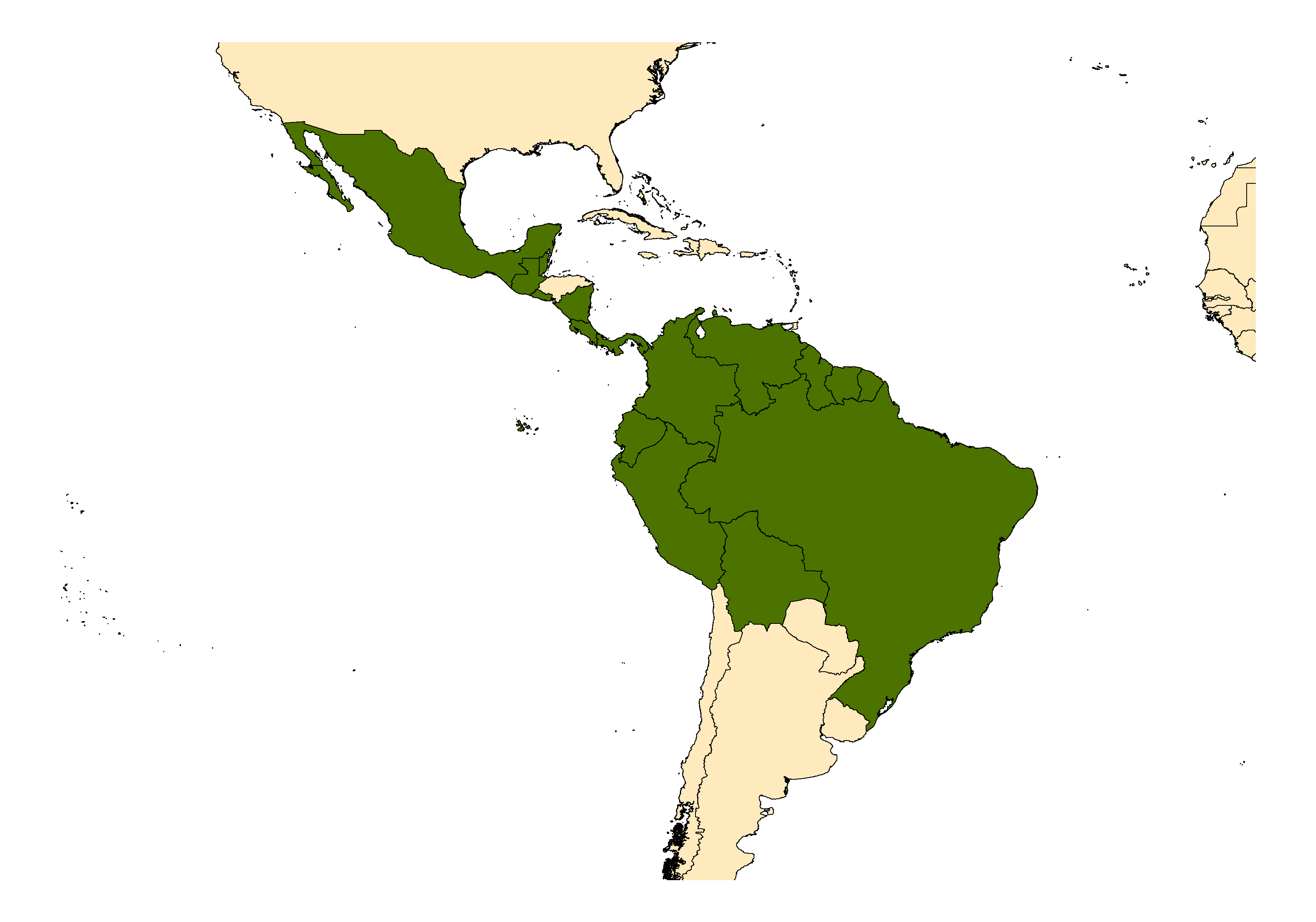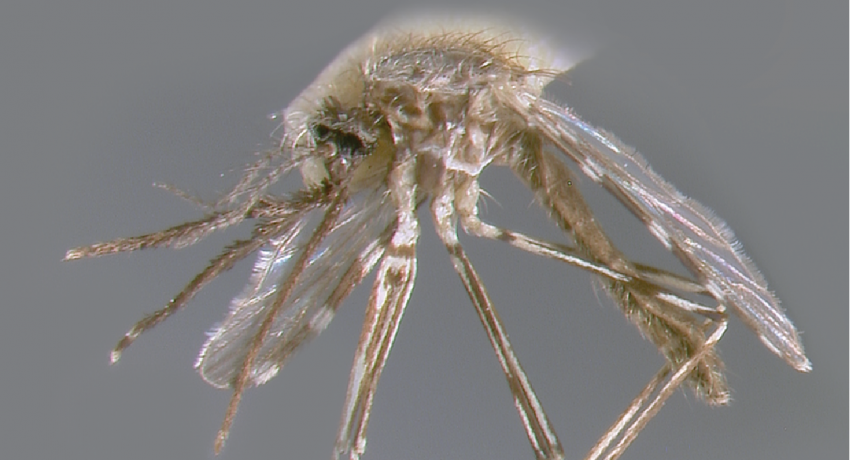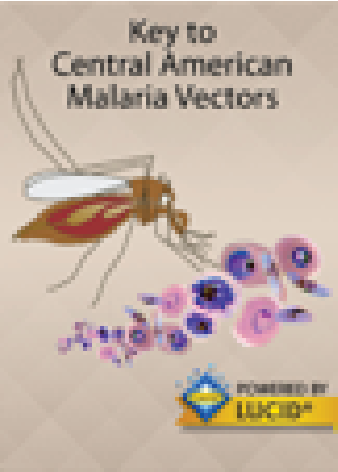NEOTROPICAL REGION
Etymology: Arthur Neiva
Anopheles neivai is perhaps the most distinctive species among an already distinctive Anopheles subgenus Kerteszia species, with white wing tips (see d) and heavy dustings of white scales covering the coxa and long parallel lines of white scales running down the femur and tibia in contrast to the broad white stripes on the tarsi (see a). The species was first described from specimens collected at Fort San Felipe, in the Porto Bello Bay region of Panama, and named in honor of the Brazilian medical entomologist, Artur Neiva (1880-1943). Anopheles neivai has an extensive distribution stretching from Chiapas in southern Mexico, through Central America to Peru, Bolivia, and Brazil in South America. However, morphological identification of An. neivai is not straightforward in the adult females, and doubtful occurrence records persist and are perpetuated, particularly those reported at higher altitudes. DNA barcoding approaches in our laboratory found at least four cryptic species within samples morphologically identified as An. neivai: An. neivai s.s. from Panama, Anopheles neivai 2 from Colombia and Venezuela, Anopheles neivai 3 from Venezuela and Ecuador, and An. neivai 4 from Ecuador. Much work remains to formally describe each of these taxa and determine the corresponding distributions of all the component taxa in the Neivai Complex.
Type locality: Fort San Felipe, Porto Bello Bay, Panama
Type depository: U.S. National Museum, Washington, D.C., United States (USNM)
DIAGNOSTIC CHARACTERS (Click photos to view; mouse over and click large photo to zoom in.)
ADULT (illustrated): Thorax: Mesepimeron with small patch of scales inserted near upper mesepimeral setae. Scutal integument silvery pruinose with four dark longitudinal stripes; scutum without pale scales on acrostichal, dorsocentral, and prescutellar areas. Legs: Ta-III2–4 with broad white bands on distal 0.5–0.7 of each tarsomere; Ta-III5 with base dark, apical 0.35–0.60 pale. Wing: Accessory sector pale spot near middle of costa, nearly equidistant between sector pale and subcostal pale spots; large pale apical fringe spot, rarely divided into 2 small pale spots. Abdomen: Terga and sterna (S) without scales, occasionally with a few scales on VII–VIII-Te and cercus.
LARVA (not illustrated): Head: Setae 5,6-C usually single; seta 11-C single or with 2,3 apical branches. Abdominal segments: Seta 1-I single, not palmate; seta 1-II–VII leaflets smooth-sided; seta 1-VII palmate; seta 6-VI long, plumose, similar to 6-III–V; seta 9-II–VII branched; seta 13-III–V usually 3-branched, but shorter than respective segments.
TAXONOMIC KEYS
Howard, Dyar & Knab 1913 (1912)
Pelaez 1945
Beltrán-Aguilar et al. 2011
Sallum, et al. 2020
![]()
Anopheles – Central America - Adult
![]()
Anopheles – Central America - Larva
![]()
WRBU - Genera - Global - Adult
![]()
WRBU - Genera - Global - Larva
![]()
WRBU - Genera - Neotropical - Adult
![]()
WRBU - Genera - Neotropical - Larva
Exemplar DNA sequences
Anopheles neivai s.l. COI: (KM234433, KM234415, KM234400, KM234385)
BIONOMICS
Immatures
Immatures of An. neivai s.l. develop in rainwater collections formed in the leaf axils of terrestrial and epiphytic bromeliads, some of which can be many meters high in the canopy. In the tropical rain forests of Panama, immatures are commonly found in arboreal bromeliads, whereas they are more likely to be found in terrestrial plants in deciduous forests. Occasionally, An. neivai s.l. immatures have been found in tree holes and aroid axils.
Adults
Populations of An. neivai s.l. increase following periods of heavy rain, when potential oviposition sites are plentiful. In the mangrove swamps along the pacific coast of Colombia, An. neivai (presumably An. neivai 2) is highly anthropophilic and regarded as a primary malaria vector. In Buenaventura, Valle del Cauca, Colombia, Plasmodium infection rates of 4.76% were reported in An. neivai, and 1.5% of females dissected showed evidence of at least ten ovipositions, indicating extremely high longevity and multiple blood feeds—bionomic factors that exponentially increase vector competence. In the same region, biting differentials were noted in relation to population age structure, with older females feeding at dawn (05:30–06:30) and nulliparous females seeking blood meals in the evening, after dusk (18:00–19:00).
DISTRIBUTION NOTES
Belize, Bolivia, Brazil, Colombia, Costa Rica, Ecuador, El Salvador, French Guiana, Guatemala, Guyana, Mexico, Nicaragua, Panama, Peru, Suriname, Venezuela.

WRBU VECTOR HAZARD REPORTS
None; View other WRBU Vector Hazard Reports
Available GIS Models:
An_neivai_Nyari_1 South & Central America
IMPORTANT REFERENCES (full citations below)
Howard, Dyar & Knab 1913 (1912) vol. 2: Pls. 41, 130 &1917: 986 (F*, L*; keys)
Komp 1937b (M*, F*, L; taxonomy; from synonym with cruzii)
Senevet & Abonnenc 1938: 509 (M*, P*, L*)
Leví-Castillo 1945: 118 (M*, F*, L*)
Pelaez 1945: 74 (F*; key)
Floch & Abonnenc 1951: 70 (M*, F*, L*)
Stone & Knight 1956b: 279 (type information, lectotype designation)
Zavortink 1973: 11 (M*, F*, P*, L*; distribution)
Baerg & Boreham 1974a: 629 (E*)
Murillo et al. 1988 (bionomics)
Astaiza-V et al. 1988 (bionomics)
Murillo et al. 1989 (bionomics)
Carvajal et al. 1989 (bionomics, distribution)
Calderón et al. 1995 (distribution; Peru)
Solarte et al. 1996 (bionomics)
Beltrán-Aguilar et al. 2011: 711 (M*, F*, P*, L*; taxonomy, keys, distribution)
Linton et al. 2013 (distribution; Ecuador)
Sallum, et al. 2020 (keys F, M, L)
CURRENT SYNONYMS
syn. hylephilus Dyar & Knab
1917: 38 (F). Type locality: Gatun, Canal Zone, Panama (USNM). References: Komp 1937b: 521 (synonymy); Belkin et al. 1965: 44 (lectotype designation).
CURRENT SUBSPECIES
None
CITED REFERENCES
Astaiza-V, R., Murillo-B, C., & Fajardo-O, P. (1988). Biology of Anopheles neivai H. D. And K., 1913 (Diptera: Culicidae) on the Pacific coast of Colombia II. Adult population fluctuation. Revista de Saúde Pública, 22(3), 101–108.
Baerg, D. C., & Boreham, M. M. (1974a). Anopheles neivai Howard, Dyar and Knab: laboratory observations on the life cycle and description of the egg stage (Diptera: Culicidae). Journal of Medical Entomology, 11(5), 629–630.
Belkin, J.N., Schick, R.X., & Heinemann, S.J. (1965). Mosquito studies (Diptera: Culicidae). V. Mosquitoes originally described from Middle America. Contributions of the American Entomological Institute, 1(5), 1–95.
Beltrán-Aguilar, A., Ibañez-Bernal, S., Mendoza-Palmero, F., Sandoval-Ruiz, C.A., & Hernández-Xoliot, R.A. (2011). Taxonomy and distribution of the anopheline mosquitoes in the state of Veracruz, Mexico (Diptera: Culicidae, Anophelinae). Acta Zoologica Mexicana Nueva Serie, 27(3), 601–755.
Calderon, G., Fernandez, R., & Valle, J. (1995). Especiés de la fauna anofelina, su distribución y algunas consideraciones sôbre su abundancia e infectividad en el Peru. Revista Peruana de Epidemiología, 8, 19.
Carvajal, H., De Herrera, M.A., Quintero, J., Alzate, A., & Herrera, S. (1989). Anopheles neivai: a vector of malaria in the Pacific lowlands of Colombia. Transactions of the Royal Society of Tropical Medicine and Hygiene, 83, 609.
Dyar, H.G., & Knab, F. (1917). Bromelicolous Anopheles (Diptera, Culicidae). Insecutor Inscitiae Menstruus, 5, 38–40.
Howard, L.O., Dyar, H.G., & Knab, F. (1913). The mosquitoes of North and Central America and the West Indies. (Vol. II) (1912). Washington, D.C.: Carnegie Institution of Washington.
Leví-Castillo, R. (1945). Estudios sôbre los anofelinos de la Region del Milagro. Temado de la Revista de la Aso. Escuela Cien. Los anofelinos de la República del Ecuador, 172.
Linton, Y.-M., Pecor, J.E., Porter, C.H., Mitchell, L.B., Garzon-Moreno, A., Foley, D H., . . . Wilkerson, R.C. (2013). Mosquitoes of eastern Amazonian Ecuador: biodiversity, bionomics and barcodes. Memórias do Instituto Oswaldo Cruz, 108 (Supplement 1), 100–109.
Murillo B., C., Astaiza V., R., & Fajardo O., P. (1988). Biologia de Anopheles (Kerteszia) neivai H., D. & K., 1913 (Diptera: Culicidae) en la costa Pacifica de Colombia. 1. Fluctuacion de la poblacion larval y caracteristicas de sus criaderos. Revista de Saúde Pública, 22(2), 94–100.
Murillo B., C., Jaramillo S., C., Quintero C., J., & Suarez T., M. (1989). Biologia de Anopheles (Kerteszia) neivai H., D. & K., 1913 (Diptera: Culicidae) en la costa pacifica de Colombia. 4. - Estructura etarea y transmission de Malaria. Revista de Saúde Pública, 23(5), 363–367.
Pelaez, D. (1945). Anofelinos de México. Clave para la determinación de especies y subespecies basada en los caracteres de las hembras adultas. Ciencia, 6, 69–77.
Ruiz-Lopez, F., Wilkerson, R.C., Ponsonby, D.J., Herrera, M., Sallum, M.A.M., Velez, I. D., . . . Linton, Y.-M. (2013). Systematics of the Oswaldoi Complex (Anopheles, Nyssorhynchus) in South America. Parasites and Vectors, 6, 13.
Sallum, M.A.M., Obando, R.G., Carrejo, N. et al. Identification key to the Anopheles mosquitoes of South America (Diptera: Culicidae). Parasites and Vectors, 13, 542 (2020). https://www.biomedcentral.com/collections/id-keys-anopheles
Senevet, G., & Abonnenc, E. (1938). Quelques anophelines de la Guyane Franҫaise. Archives de l'Institut Pasteur d'Algérie, 16, 486–512.
Solarte, Y., Hurtado, C., González, R., & Alexander, B. (1996). Man-biting activity of Anopheles (Nyssorhynchus) albimanus and An. (Kerteszia) neivai (Diptera: Culicidae) in the Pacific lowlands of Colombia. Memórias do Instituto Oswaldo Cruz, 91(2), 141–146.
Stone, A., & Knight, K.L. (1956b). Type specimens of mosquitoes in the United States National Museum. III. The genera Anopheles and Chagasia (Diptera, Culicidae). Journal of the Washington Academy of Sciences, 46(9), 276–280.
Zavortink, T.J. (1973). Mosquito studies (Diptera, Culicidae). XXIX. A review of the subgenus Kerteszia of Anopheles. Contributions of the American Entomological Institute, 9(3), 1–54.
CITE THIS PAGE
Walter Reed Biosystematics Unit (Year). Anopheles neivai species page. Walter Reed Biosystematics Unit Website, http://wrbu.si.edu/vectorspecies/mosquitoes/neivai, accessed on [date (e.g. 03 February 2020) when you last viewed the site].












































































































































































